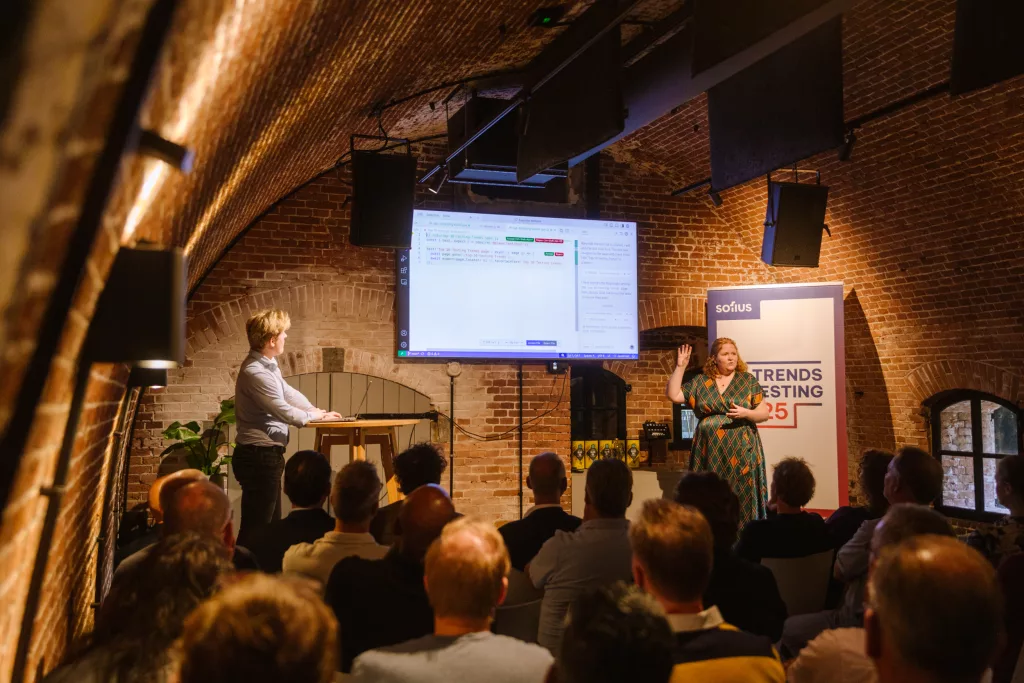Test strategy is number five in the Top 10 Trends in Testing. It may not sound hip and it is certainly not a buzzword, but year after year it remains one of the most important trends in software testing. In a world full of CI/CD, microservices, and DevOps, a good test strategy is not a luxury, but a foundation. Without a strategy, you test on instinct. With a strategy, you create direction, priority, insight, and confidence.
What we are seeing is that test strategy is not a static document, but a living framework that evolves with innovation. This is also evident from our experience with a major Dutch bank: by critically approaching the test strategy and strategically applying Quality Engineering, chain testing as we know it proved largely unnecessary. The result? Fewer dependencies, faster feedback, and greater confidence in quality. Not by testing more, but by thinking smarter.
Test Strategy as a Foundation
A test strategy does not consist of a single choice, but of a cohesive whole of building blocks. And every element helps to deploy testing smarter, earlier, and more focused. In your test strategy, you make choices about test environments, test goals, risks, test data, automation, and test types. Central to this is your intention. What do you want to achieve? Do you want to minimize risks, ensure quality, or increase speed? Depending on the goal, you choose the approach. And because a project is always in motion, your goal can easily change. For example, you can shift from fault detection to quality assurance. And naturally, if your goal changes, your approach changes too.
Chain Testing: A Traditional Bottleneck
For many organizations, chain testing is a reflex. In complex application landscapes with multiple chain partners, it seems like the safe choice. But a reflex is not a strategy. A good test strategy offers a network of choices that collectively address the risks, goals, and context. A good test strategy is not a linear chain that links everything together.
A striking example comes from the practice of a major Dutch bank. Ten years ago, the bank still worked according to the waterfall method: four large releases per year, with long regression tests, system tests, chain tests, and acceptance tests. It was a tense moment when the bank reopened after the weekend. Incidents were inevitable and often required weeks of recovery work.
From Long Chain Tests to Autonomous Teams
The desire to become faster and operate more agile led to a radical change. The bank switched to autonomous DevOps teams. The motto became: You build it, you run it, you love it. Each team was responsible for its application, including production, incidents, and quality assurance. The challenge: how do you go from eight weeks of testing time to ‘eight minutes’?
The key lay in critically examining the chain test. Long chain tests were time-consuming, fragile, and limited the autonomy of teams. Instead of completely abolishing them, they searched for alternatives: smaller releases, early risk addressing, and smart test strategies.
Small Releases, Big Impact
A concrete example is an SQL application with more than 5,500 tables and 350 APIs. Previously, everything was tested and rolled out once every three months, which entailed enormous risks and complexity. Today, the application goes into production daily, often with only a few small changes. This lowers the risks, speeds up feedback, and increases confidence in the system.
The shift-left approach (testing early) and contract-based testing ensure that APIs remain consistent and that teams can act quickly in case of deviations. At the same time, only a few end-to-end tests remain at the top of the test pyramid to verify coherence, thereby minimizing expensive and slow tests.
Mindset and Organization: The Secret Behind Success
Technology alone is not enough. Letting go of chain testing requires a culture change. At the bank, events such as Autonomous Together were organized to shift the mindset and engage employees. In addition, a new role was introduced: a Quality Engineer in every squad. These engineers are actively involved, perform tests themselves, and ensure that the squad remains continuously critical of risks, the test approach, and implementation.
Guilds and workshops ensure knowledge sharing and facilitate discussion of lessons, allowing successes and areas for improvement to be widely disseminated. Standardized pipelines and frameworks create security and consistency, while teams maintain their autonomy.
Conclusion: Dare to Break with Chain Testing
Chain tests are not a silver bullet. They are often a time-consuming reflex that curbs speed and agility. The experience of the major Dutch bank shows that it is possible to reduce chain testing to a minimal, risk-mitigating level. By testing early, performing small releases, applying contract-based testing, and organizing quality within teams, a network of choices is created that offers confidence and speed.
An effective test strategy is not a chain that connects everything, but a flexible network that responds to risks, goals, and context. Dare to break with traditional chain testing and build a test strategy that truly adds value.
Are you curious about how a smart test strategy can help your organization move forward? Our experts would be happy to discuss the possibilities and concrete steps with you. Feel free to contact us.




